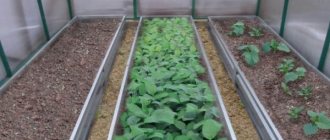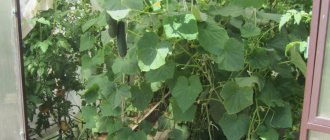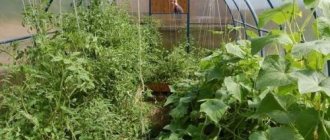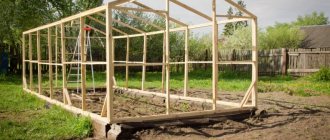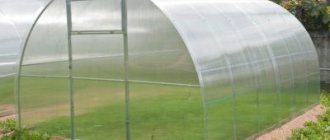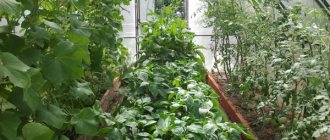The main condition for a good harvest of cucumbers is increased humidity and temperature stability. Such conditions are difficult to provide in open ground, and therefore this crop is often grown in a greenhouse.
Caring for cultivated plants in a greenhouse requires a lot of effort, so it would be irrational to leave empty space. And here the question arises, what can be planted with cucumbers in a greenhouse. It is worth choosing crops that require similar care. By choosing the right neighbors, you can get a bountiful harvest, doing less work, and also saving space.
Why some crops cannot be planted next to cucumbers
The space on the site for installing a greenhouse is limited, so you need to select neighbors very carefully. For many decades, people have been studying the interaction between neighboring plants. Proper placement of crops helps protect them from diseases and pests, as well as increase productivity. And all this without the constant application of mineral fertilizers, which saves money and makes the products more environmentally friendly.
Plants create favorable conditions for each other for growth, healing the soil, feeding it with useful substances, in particular nitrogen. Other plants loosen the soil with their roots, prevent harmful weeds from growing, and prevent soil depletion and weathering.
Some plants attract pollinating insects for various crops in the garden, as well as birds and pest-killing insects. Other plants drive away rodents and harmful insects that spoil the crop.
It is also necessary to think through a planting plan because different crops require special growing conditions. What is good for one may be bad for another. Cucumbers require moist air and constant maintenance of moist soil, infrequent but plentiful. These conditions are not suitable for many garden plants. For example, it is difficult for nightshades (potatoes) to grow next to cucumbers; they become depressed and weak. High temperature and humidity are not good for tomatoes. However, some gardeners successfully grow tomatoes with cucumbers. An example will be the heroine of the video posted at the end of the article.
Features of growing cucumbers
Cucumbers need to be planted on fertile, light and warm soil that does not become waterlogged and contains many nutrients. In the fall, when preparing the bed for the next year, rotted manure or compost is added at the rate of 5-6 kg per 1 sq.m. When decomposition processes begin, heat is released and the bed is saturated with nutrients. And cucumber leaves absorb carbon dioxide released during the decomposition of manure.
Every morning, the cucumbers are watered with warm, settled water. They have a superficial root system, which is also fragile and delicate. Lack of oxygen and damage lead to their death, or damage to spider mites and diseases. Therefore, the soil must be kept loose and moderately moist. This option is not suitable for most plants.
Cucumbers are picky about temperature.
When it drops to 10 degrees, the leaves turn yellow and growth stops. When it drops to 5 degrees and below, the leaves fall off and are affected by powdery mildew. And when the air temperature rises, the pollen in the flowers sticks together, they are not pollinated, and the flowers fall off.
It is best to grow cucumbers vertically; to do this, they are tied to a trellis. This makes them easier to care for and reduces the risk of disease and pest damage.
This growing principle is not suitable for all plants. Not all crops are suitable for growing together with cucumbers for the following reasons:
- Spreading mustaches of cucumbers can oppress neighbors in the garden.
- Also, on the contrary, neighboring plants may have too strong a root system, which will not allow the cucumber plant to develop.
- Other plants will draw all the moisture from the ground, which creates extremely unfavorable conditions for cucumbers.
- It is not recommended to grow plants belonging to the same family nearby, as they will “argue” with each other.
- Neighbors can consume a lot of nitrogen, which is necessary for the growth and development of cucumbers.
Sowing beets
Proper seed preparation speeds up the appearance of the first shoots by 2 times. Preparation includes:
- selection of the largest seeds;
- soaking in water or a solution of trace elements;
- germination;
- disinfection, bubbling and pelleting of seeds (optional conditions).
The seeds are soaked at a temperature of 20-22 degrees - they are collected in a cotton bag, and then placed in water for a couple of days. The water in the container needs to be changed every 6-8 hours. After the first shoots appear, the seeds are dried until they flow.
What can you plant in a greenhouse next to cucumbers?
Before you organize your garden, look at which crops get along well next to cucumbers, which will be good predecessors and successors after green vegetables.
Cucumbers get along well with the following crops.
Eggplant
Crops have similar requirements for watering and care. When growing them together, you need to provide the cucumbers with supports for the vines in time, then they will not oppress each other. If you plant eggplants in a greenhouse together with cucumbers, then plant the eggplants in a sunny place first, since the wide leaves of cucumbers can shade them.
Will bell peppers grow along with cucumbers?
This is another advantageous neighborhood. Peppers like the same growing conditions as cucumbers. They do not tolerate drafts, dry soils and dry, hot air. Just tie up the vines so as not to shade the nightshade crop. Cabbage and peppers are also excellent predecessors for garden beds in front of cucumbers.
Here's what you can plant in a greenhouse with cucumbers
Zucchini
Both cultures do not oppress each other. Their proximity is not dangerous, since they do not inter-pollinate, although they are relatives. Both plants love water and light. But make sure that the large zucchini leaves do not shade the cucumber leaves.
Corn and cucumbers
For large garden plots this is one of the best combinations. Corn serves as a curtain for cucumbers, protecting them from the scorching sun and drafts. The root systems differ: in the first they go deep, in the greenfinch they are superficial. Plus, the vines of cucumbers curl perfectly along the stems of a strong neighbor.
Neighborhood of cucumber and onion
Both plants are friendly to each other. The meadow is also an excellent predecessor for cucumbers. But it is better not to plant onions immediately after cucumbers; first grow legumes in this place.
Is it possible to plant garlic next to cucumbers?
This neighbor is great for cucumbers. It repels pests.
Peas and beans near cucumbers
Legumes saturate the soil with nutrients, especially nitrogen. Therefore, if they grow nearby or even in the middle of the garden bed, the yield of cucumbers increases.
Chives
If you plant both crops side by side, cucumbers will not suffer from powdery mildew.
Will cucumbers grow next to carrots?
These plants in neighboring beds do not negatively affect each other in any way.
Is it possible to plant dill with cucumbers?
This aromatic herb is an exception among spicy plants; it is not advisable to plant others. It is useful to grow wormwood, thyme and thyme nearby; they repel pests such as slugs that eat young fruits.
Cucumbers also work well with radishes, different varieties of cabbage and broccoli, mustard and spinach.
Useful articles:
Growing radishes
How to grow cabbage
Growing and caring for Broccoli
When to sow and when to bury mustard in the ground
Many gardeners are concerned about whether it is possible to plant different varieties of cucumbers side by side . There is no definite answer, since if the varieties are pollinated, then as a result of proximity they can be cross-pollinated. If the varieties are self-pollinating, then nothing bad should happen. But even in the first case this is not catastrophic. It all depends on whether you will use grown seeds or plant purchased ones every year. In case of cross-pollination, fruits can receive varietal characteristics of each other. For home use this is not important .
Advice from experienced summer residents
To get a high yield, you should follow a number of tips.
When only one greenhouse is installed on a garden plot, but a large number of plants need to be planted, an unfavorable neighborhood cannot be avoided. Partitions installed between crops will help solve the problem. Zelentsy and an undesirable crop as a neighbor will not come into contact. Thanks to the zoning of the site in open ground or a greenhouse, there will be no problems with vegetables, fruits or herbs.
The various structures through which the plants are separated should not be cumbersome. Partitions cannot restrict access to plants from ultraviolet rays and air.
Another option suitable for a greenhouse: multi-story beds or hanging pots in which you can grow a variety of seedlings. So, cucumbers will not come into contact with unwanted neighbors. For example, tomatoes and peppers are placed in a similar way.
If we talk about herbs, they should be planted, at least through a garden bed.
Previous CucumbersWhy do cucumber leaves dry out: causes and methods of treatment Next CucumbersWhat to do if cucumbers bloom but there is no ovary
What not to plant next to cucumbers
And although it is believed that cucumbers do not have an unfortunate neighborhood, there are nevertheless a number of plants that should not be planted next to cucumbers. These include:
- basil, arugula and other aromatic, fragrant herbs. They oppress cucumbers.
- fennel _ It has a powerful root system that grows strongly and draws all the moisture and nutrients from the soil.
- tomatoes . Nightshades take the same nutrients from the soil that cucumbers need. Plus they require completely different growing conditions. Next to cucumbers, they will simply drown and will constantly get sick. However, there is no clear opinion among gardeners on this matter. If you maintain distance and agricultural technology, then tomatoes and cucumbers can coexist in the same greenhouse.
- potato. The situation with it is the same as with tomatoes. Plus, cucumbers and potatoes are mutually inhibiting plants. Potatoes take up all the water and nutrients and shade the cucumbers. In addition, they share common pests and diseases.
- strawberry . Plants require different care; from frequent watering, garden strawberries will quickly drown and begin to hurt. But cucumbers do not like very sunny places, their leaves turn yellow, and productivity decreases.
- Watermelons and melons belong to the same family as cucumbers. Therefore, in order to avoid cross-pollination, it is undesirable to plant them next to each other. Plants will oppress each other. The leaves of melon and watermelon are much larger than cucumber leaves, so they will shade them.
Compatibility table
| Perfect | Neutral | Undesirable |
| cabbage | tomato | potato |
| onion | pepper | pumpkin |
| garlic | eggplant | watermelon |
| beans | radish | melon |
| beet | radish | sage |
| sunflower | strawberry | petunia |
| peas | celery | basil |
| corn | oregano | |
| marigold | cilantro | |
| calendula | spinach |
What is recommended to plant with cucumbers and what should not be placed next to the cucumber bed.
The neighbors of cucumbers in the garden is a controversial and often discussed topic, so it is better to rely both on the advice of experienced gardeners and on your own observations. By organizing the correct proximity of crops on the site, you can not worry about obtaining a harvest of tasty, healthy vegetables.
Zoning and partitions
Zoning a garden plot is an important part of its organization. If the beds are placed chaotically, then not all crops will receive the necessary care. Planting should be done in a certain order and with a convenient location of the water source. This will help maintain enthusiasm for caring for the area and prevent it from developing into a duty and punishment.
Significant points in organizing the site are the following:
- Zone the beds according to the rule: the more care required, the closer they need to be. The same applies to greenhouses. If you feel unwell or don’t want to, the plants will be at hand, and you won’t have to drag heavy buckets and a hose to water the beds.
The same system works for mixed beds. Plant things that need frequent watering closer together. If you combine cucumbers with anything else, then place the cucumbers closer.
- Look where the shadow falls. Partial shade is suitable for cucumbers; they will produce a little less yield, but they will not get sick. That's why they are planted next to sunflowers and corn.
- Separate cucumber beds with borders, flowers or greenery. Onions, garlic, marigolds, dill and thyme are suitable for this. This will help limit the decaying vines of cucumbers and preserve the fruits from damage while walking along the paths. Broken brick, tiles, slate, large pebbles, even empty bottles are suitable for creating a border.
- Place natural hedges on the east and south sides. This will help protect the cucumbers from the hot sun during the heat of the day.
Another condition for successfully growing cucumbers is the installation of a modern irrigation system. This will make it easier to irrigate on time when you are unable to do it yourself.
Conclusion
We told you what you can plant in a greenhouse with cucumbers. The culture gets along well with many plants, so organizing beds for cucumbers is not difficult. If you don’t plant a number of crops nearby, you will get a bountiful and tasty harvest.
Erets are excellent predecessors for the beds in front of cucumbers.
Here's what you can plant in a greenhouse with cucumbers
Zucchini
Both cultures do not oppress each other. Their proximity is not dangerous, since they do not inter-pollinate, although they are relatives. Both plants love water and light. But make sure that the large zucchini leaves do not shade the cucumber leaves.
Corn and cucumbers
For large garden plots this is one of the best combinations. Corn serves as a curtain for cucumbers, protecting them from the scorching sun and drafts. The root systems differ: in the first they go deep, in the greenfinch they are superficial. Plus, the vines of cucumbers curl perfectly along the stems of a strong neighbor.
Neighborhood of cucumber and onion
Both plants are friendly to each other. The meadow is also an excellent predecessor for cucumbers. But it is better not to plant onions immediately after cucumbers; first grow legumes in this place.
Is it possible to plant garlic next to cucumbers?
This neighbor is great for cucumbers. It repels pests.
Peas and beans near cucumbers
Legumes saturate the soil with nutrients, especially nitrogen. Therefore, if they grow nearby or even in the middle of the garden bed, the yield of cucumbers increases.
Chives
If you plant both crops side by side, cucumbers will not suffer from powdery mildew.
Will cucumbers grow next to carrots?
These plants in neighboring beds do not negatively affect each other in any way.
Is it possible to plant dill with cucumbers?
This aromatic herb is an exception among spicy plants; it is not advisable to plant others. It is useful to grow wormwood, thyme and thyme nearby; they repel pests such as slugs that eat young fruits.
Cucumbers also work well with radishes, different varieties of cabbage and broccoli, mustard and spinach.
Useful articles:
Growing radishes
How to grow cabbage
Growing and caring for Broccoli
When to sow and when to bury mustard in the ground
Many gardeners are concerned about whether it is possible to plant different varieties of cucumbers side by side . There is no definite answer, since if the varieties are pollinated, then as a result of proximity they can be cross-pollinated. If the varieties are self-pollinating, then nothing bad should happen. But even in the first case this is not catastrophic. It all depends on whether you will use grown seeds or plant purchased ones every year. In case of cross-pollination, fruits can receive varietal characteristics of each other. For home use this is not important .
Basic rules of crop rotation
Proper rotation of crops is the key to high productivity. There are good and bad predecessors for cucumbers.
Nightshades and legumes are considered good predecessors. The only exception is beans. Speaking of nightshades, it is worth highlighting potatoes and tomatoes. Cucumbers also grow well after onions, of any variety. They can be successfully grown after cauliflower or white cabbage and many root vegetables. Carrots and beans cannot be included here, as they are susceptible to white rot (this disease is fatal to the cucumber crop).
Beetroot is a neutral precursor. Also, without any problems, the crop can be planted in the garden bed where radishes were previously collected.
What not to plant next to cucumbers
And although it is believed that cucumbers do not have an unfortunate neighborhood, there are nevertheless a number of plants that should not be planted next to cucumbers. These include:
- basil, arugula and other aromatic, fragrant herbs. They oppress cucumbers.
- fennel _ It has a powerful root system that grows strongly and draws all the moisture and nutrients from the soil.
- tomatoes . Nightshades take the same nutrients from the soil that cucumbers need. Plus they require completely different growing conditions. Next to cucumbers, they will simply drown and will constantly get sick. However, there is no clear opinion among gardeners on this matter. If you maintain distance and agricultural technology, then tomatoes and cucumbers can coexist in the same greenhouse.
- potato . The situation with it is the same as with tomatoes. Plus, cucumbers and potatoes are mutually inhibiting plants. Potatoes take up all the water and nutrients and shade the cucumbers. In addition, they share common pests and diseases.
- strawberry . Plants require different care; from frequent watering, garden strawberries will quickly drown and begin to hurt. But cucumbers do not like very sunny places, their leaves turn yellow, and productivity decreases.
- Watermelons and melons belong to the same family as cucumbers. Therefore, in order to avoid cross-pollination, it is undesirable to plant them next to each other. Plants will oppress each other. The leaves of melon and watermelon are much larger than cucumber leaves, so they will shade them.
Zoning and partitions
Zoning a garden plot is an important part of its organization. If the beds are placed chaotically, then not all crops will receive the necessary care. Planting should be done in a certain order and with a convenient location of the water source. This will help maintain enthusiasm for caring for the area and prevent it from developing into a duty and punishment.
Significant points in organizing the site are the following:
- Zone the beds according to the rule: the more care required, the closer they need to be. The same applies to greenhouses. If you feel unwell or don’t want to, the plants will be at hand, and you won’t have to drag heavy buckets and a hose to water the beds.
The same system works for mixed beds. Plant things that need frequent watering closer together. If you combine cucumbers with anything else, then place the cucumbers closer.
- Look where the shadow falls. Partial shade is suitable for cucumbers; they will produce a little less yield, but they will not get sick. That's why they are planted next to sunflowers and corn.
- Separate cucumber beds with borders, flowers or greenery. Onions, garlic, marigolds, dill and thyme are suitable for this. This will help limit the decaying vines of cucumbers and preserve the fruits from damage while walking along the paths. Broken brick, tiles, slate, large pebbles, even empty bottles are suitable for creating a border.
- Place natural hedges on the east and south sides. This will help protect the cucumbers from the hot sun during the heat of the day.
Another condition for successfully growing cucumbers is the installation of a modern irrigation system. This will make it easier to irrigate on time when you are unable to do it yourself.
